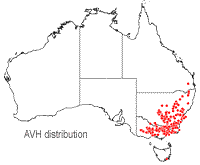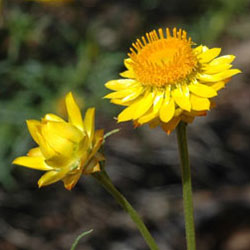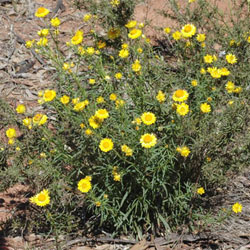Xerochrysum viscosum
Sticky Paper Daisy, Sticky Everlasting
Xerochrysum viscosum (DC.) R.J.Bayer
Xerochrysum viscosum is a common daisy native to Australia. It is also known as Sticky Everlasting, Yellow Paper Daisy, Shiny Everlasting or Golden Everlasting.
In 1991, the name Helichrysum viscosum was changed to Bracteantha viscosa. However it was not realised that one year earlier Xerochrysum viscosum had already been published and priority came to this genus when this was discovered in 2001. Xerochrysum now consists of seven widespread species within the family of Asteraceae.
 X. viscosum naturally grows in south eastern Australia occurring in Queensland, New South Wales, Victoria, Australian National Territory and Tasmania. It is widespread in open eucalypt woodland or sclerophyll forest, and is an opportunist in disturbed areas such as roadsides and goldfields in Victoria.
X. viscosum naturally grows in south eastern Australia occurring in Queensland, New South Wales, Victoria, Australian National Territory and Tasmania. It is widespread in open eucalypt woodland or sclerophyll forest, and is an opportunist in disturbed areas such as roadsides and goldfields in Victoria.
X. viscosum is an erect low growing perennial herb of multiple stem growth. It grows between 20-80cm high and 30-80cm wide with bright green linear or elliptic leaves of 30-100mm long and 2-10mm wide with a sticky, rough surface. The bright yellow flower heads are 20-30mm wide, attractive and long lasting. The papery bracts display the colours of lemon, gold, splotchy orange to bronze.
The daisy can be easily grown in most soils that are well drained. It prefers full sun exposure, but will be short lived in shade. It flowers during spring and summer and may extend into autumn. It forms large clusters of flower heads and should be pruned back after flowering in late autumn or early winter to stimulate new shoots for further flowering and to maintain bushiness. X. viscosum will resist frost and drought areas, and will grow in humid conditions. In a garden, grouped planting will deliver a brilliant spread of colour and brightness to an open sunny space or rockery. The flower heads can be easily cut, dried and preserved whist retaining colour for floral display.
X. viscosum can be propagated easily by both seed and cutting. Fruits are wind dispersed and can be hand collected during the summer months. Cool stratification may be necessary for successful germination. Seeds can be thinly sowed directly into soil bed in autumn and will germinate within 7-30 days. Cuttings should be 75mm in length with lower leaves and flower heads removed. Cuttings should be dipped in a weak root hormone solution of 500-1500ppt to increase strike rate. Propagation medium should be 3 parts coarse sand and 1 part peat moss. In its natural habitat, seedlings colonize large areas after fire and most often grow on sandy to sandy loam soils, but it will have difficulty germinating in areas with compacted soil and thick organic mulch.
The flower heads are insect pollinated and will provide food for native butterflies and larvae. However, X. viscosum may be affected by aphid attack and young seedlings are predated by slugs and snails.
X. viscosum closely resembles Xerochrysumbracteatum, but it is distinguished by broader hairy leaves and larger flower heads.
Text by Jonathan Carr (2010 Student Botanical Intern)
Name Meaning: Xerochrysum viscosumXerochrysum - from Greek xeros meaning “dry” and chrysos meaning “gold” (this refers to the common yellow papery bracts that occur within the genus) viscosum - from Latin viscosus meaning “sticky” (refers to leaf character) |
References
Australian Daisy Study Group, (1987) Australian Daisies for gardens and floral art, Lothian Publishing Company Pty Ltd, Melbourne.
Australian Daisy Study Group, (2002) Everlasting Daisies of Australia: Identification, Propagation, Cultivation, C.H. Jerram & Associates Science Publishers, Victoria.
Bayer, R.J. (2001) ‘ Xerochrysum Tzvelev, a Pre-Existing Generic Name for Bracteantha Anderb. & Haegi (Asteraceae: Gnaphalieae)’, Kew Bulletin, vol. 56, no. 4, pp.1013-1015, viewed 13 February 2010, <http://www.jstor.org/stable/4119317>
Brunskill, S. (2008) A Selection of Indigenous Plants of Albury Wodonga & Surrounds, TAFE NSW – Riverina Institute, National Environment Centre.
Cunningham, G.M., Mulham, W.E., Milthorpe, P.L & Leigh J.H. (1981) Plants of Western New South Wales, Soil Conservation Service of NSW, NSW Government Printing Office, Sydney.
Elliot, R.W & Jones, D.L. (1993) Encyclopaedia of Australian Plants Suitable for Cultivation, vol. 5, Lothian Publishing Co. Pty. Ltd, Melbourne.
Harden, G.J. (1991) Flora of New South Wales, vol. 3, NSW University Press, Kensington, NSW.
![An Australian Government Initiative [logo]](/images/austgovt_brown_90px.gif)



